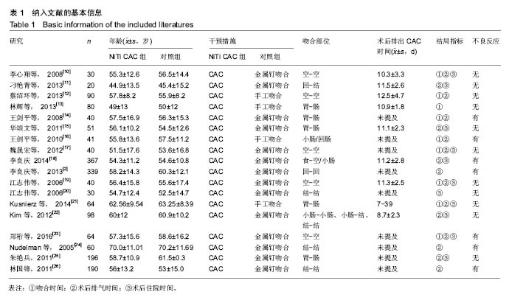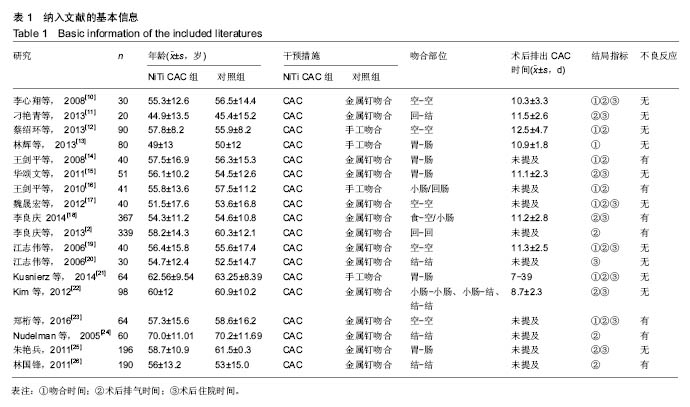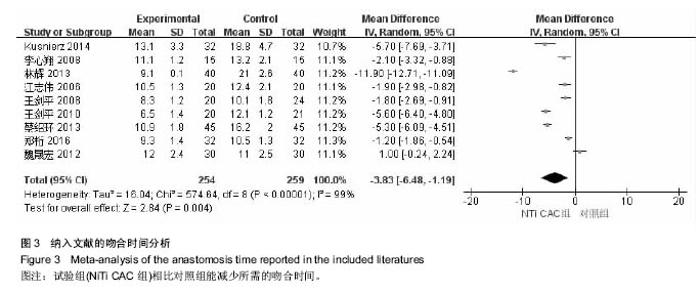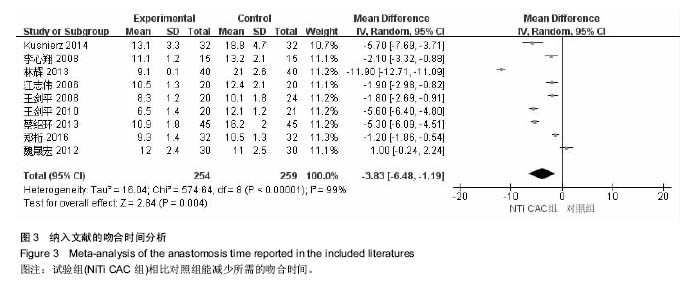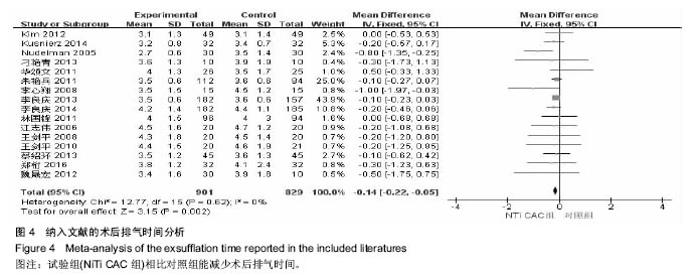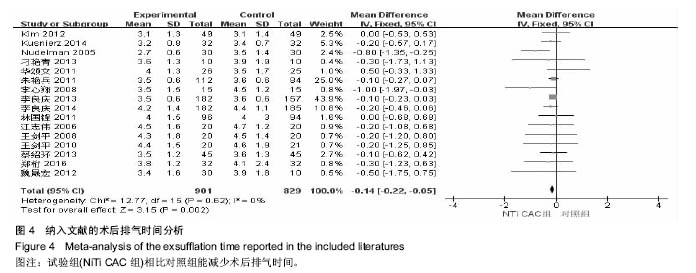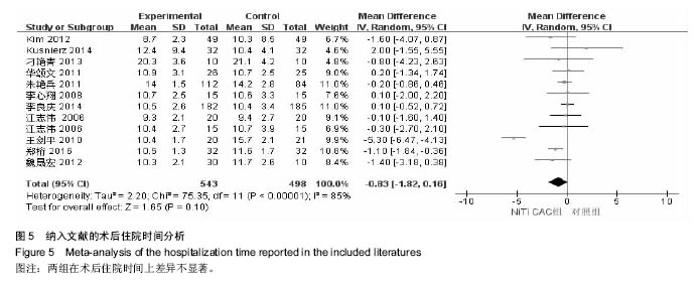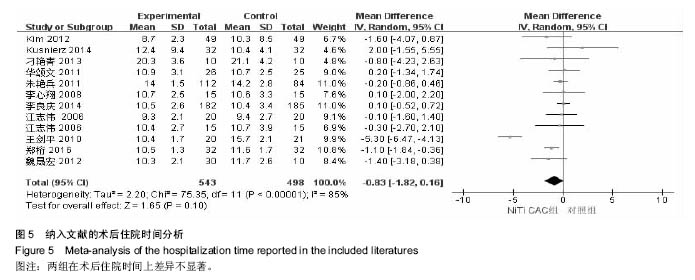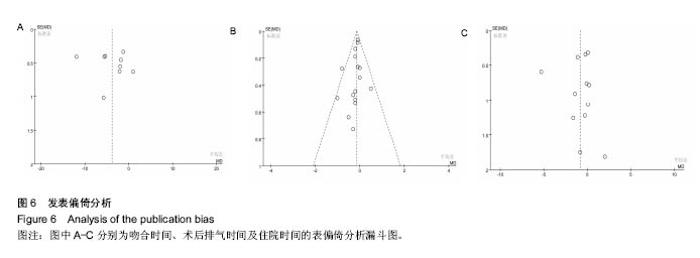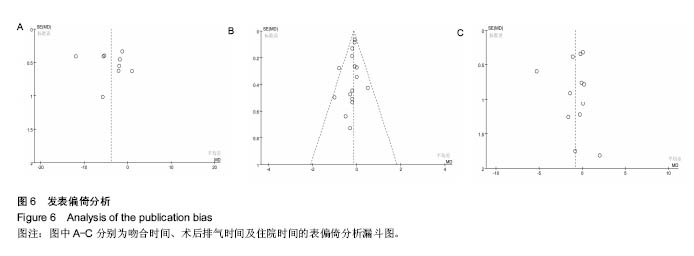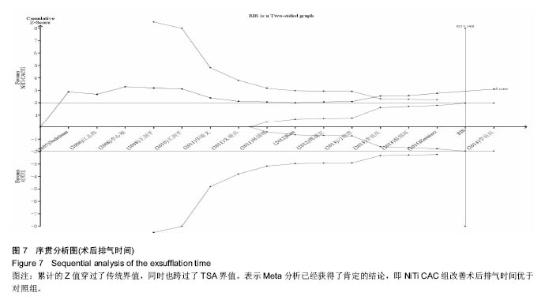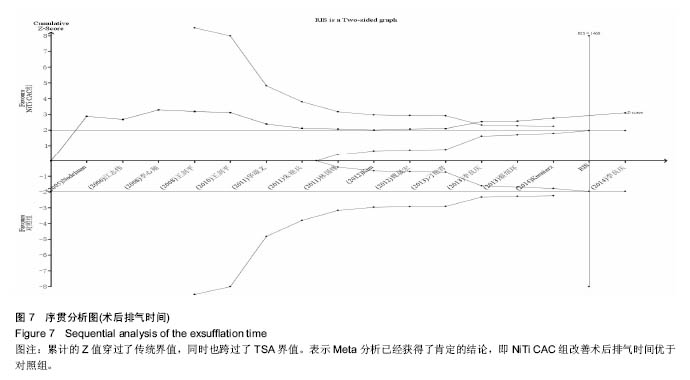| [1]Choy PY, Bissett IP, Docherty JG, et al. Stapled versus handsewn methods for ileocolic anastomoses. cochrane database of systematic reviews. Cochrane Database Syst Rev. 2007;9(9):D4320.[2]李良庆,傅木海,潘敦.镍钛记忆合金加压吻合夹在胃肠吻合中的应用[J].中华消化外科杂志,2013,12(7):504-507.[3]Li NN, Zhao WT, Wu XT. Can a nickel-titanium memory-shape device serve as a substitute for the stapler in gastrointestinal anastomosis? A systematic review and meta-analysis. J Surg Res. 2016;201(1):82-93.[4]尹剑辉,张力君,徐林,等.镍钛记忆合金加压吻合环在消化道吻合重建中有效性及安全性的Meta分析[J].中国医学创新,2016, 13(29):26-30.[5]翁鸿,武珊珊,张永刚,等.序贯Meta分析方法学简介[J].中国循证医学杂志,2016,16(10):1216-1220.[6]田金徽,葛龙,娄丽丽,等.中药注射剂联合CF化疗方案治疗乳腺癌有效性及安全性的网状Meta分析和试验序贯分析[J].中国全科医学,2016,19(27):3326-3335.[7]陈昊,王艳,胡轩铭,等.GRADEpro GDT在干预性系统评价证据质量分级中的应用[J].中国循证医学杂志,2015,15(5):600-606.[8]翁鸿,李胜,曾宪涛,等.试验序贯分析软件在Meta分析中的应用[J].中国循证医学杂志,2016,16(5):604-611.[9]王权,田金徽,李伦,等.试验序贯分析与Meta分析所需样本量的估算[J].兰州大学学报(医学版),2015,41(4):76-80.[10]李心翔,叶建新,石铮,等.镍钛记忆合金加压吻合夹用于全胃切除术后消化道重建效果分析[J].中国实用外科杂志,2008,28(7): 559-560.[11]刁艳青,江志伟,汪志明,等.应用镍钛记忆合金加压吻合夹进行回肠结肠吻合的临床研究[J].医学研究生学报,2013,26(03): 274-276.[12]蔡绍环,徐志峰,杨永锐,等.镍钛记忆合金加压吻合夹在全胃切除术中的应用[J].医学综述,2013,19(2):379-380.[13]林辉.镍钛记忆合金加压吻合器在胃肠吻合术中的应用[J].福建医药杂志,2013,35(1):3-5.[14]王剑平,徐志峰,王明元,等.镍钛记忆合金加压吻合夹在胃肠吻合中的应用[J].世界华人消化杂志,2008,16(16):1812-1814.[15]华颂文,熊力,文宇,等.应用镍钛记忆合金加压吻合夹行胃肠吻合的安全性与有效性分析[J].中南大学学报(医学版),2011,36(4): 351-354.[16]王剑平,徐志峰,王明元,等.镍钛记忆合金加压吻合夹在晚期癌性肠梗阻短路吻合中的应用[J].肿瘤防治研究,2010,37(6): 702-704.[17]魏晟宏,陈路川,余辉.镍钛记忆合金加压吻合夹在胃癌术后消化道重建中应用的临床观察[J].福建医药杂志,2012,34(4):33-34.[18]李良庆,栗大伟,杨洋.镍钛记忆合金加压吻合夹行小肠吻合182例[J].广东医学,2014,35(3):390-392.[19]江志伟,李宁,黎介寿,等.应用镍钛记忆合金加压吻合夹进行小肠吻合的临床研究[J].中华胃肠外科杂志,2006,9(5):392-394.[20]江志伟,李宁,黎介寿,等.应用镍钛记忆合金加压吻合夹进行结肠吻合的临床研究[J].中国实用外科杂志,2006,26(5):364-365.[21]Kusnierz K, Lekston Z, Zhavoronkov D, et al. A nickel-titanium memory-shape device for gastrojejunostomy: comparison of the compression anastomosis clip and a hand-sewn anastomosis. J Surg Res. 2014;187(1):94-100.[22]Kim HR, Lee WY, Jung KU, et al. Early surgical outcomes of niti endoluminal compression anastomotic clip (NiTi CAC 30) use in patients with gastrointestinal malignancy. J Laparoendosc Adv Surg Tech A. 2012;22(22):472-478.[23]郑桁,杨春,郭志义,等.镍钛记忆合金加压吻合夹用于胃肠道吻合的安全有效性[J].中国组织工程研究,2016,20(43):6458-6464.[24]Nudelman I, Fuko V, Waserberg N, et al. Colonic anastomosis performed with a memory-shaped device. Am J Surg. 2005; 190(3):434-438.[25]朱艳兵.镍钛记忆合金加压吻合夹进行胃肠吻合的临床研究[D].福州:福建医科大学,2011.[26]林国锋.镍钛记忆合金加压吻合夹在结肠癌手术中的临床研究[D].福州:福建医科大学,2011.[27]曾毅,陈夏,应敏刚.镍钛记忆合金加压吻合夹在腹腔镜结肠癌手术中的应用[J].中华胃肠外科杂志,2007,10(6):539.[28]刁艳青,江志伟,汪志明,等.应用镍钛记忆合金加压吻合夹进行回肠结肠吻合的临床研究[J].医学研究生学报,2013,26(3): 274-276.[29]蔡绍环,徐志峰,杨永锐,等.镍钛记忆合金加压吻合夹在全胃切除术中的应用[J].医学综述,2013,19(2):379-380.[30]郑鹏,许剑民.结直肠吻合术后吻合口瘘的防治[J].中华胃肠外科杂志,2016,19(4):379-382.[31]张盼,娄培安.CONSORT声明在随机对照试验研究中的应用[J].中华全科医学,2016,14(5):835-837.[32]温万鑫,卢静敏,陆丽明,等.国内应用CONSORT及STRICTA评价RCT的现状分析[J].中医杂志,2015,56(18):1559-1563.[33]薛文,刘舒娆,管晓鹂,等.微创经皮与传统开放椎弓根螺钉置入固定胸腰椎骨折的文献荟萃[J].中国组织工程研究,2016,20(13): 1961-1969. |
